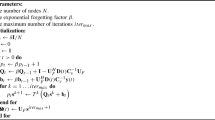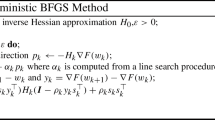Abstract
We consider sparsity-based techniques for the approximation of high-dimensional functions from random pointwise evaluations. To date, almost all the works published in this field contain some a priori assumptions about the error corrupting the samples that are hard to verify in practice. In this paper, we instead focus on the scenario where the error is unknown. We study the performance of four sparsity-promoting optimization problems: weighted quadratically-constrained basis pursuit, weighted LASSO, weighted square-root LASSO, and weighted LAD-LASSO. From the theoretical perspective, we prove uniform recovery guarantees for these decoders, deriving recipes for the optimal choice of the respective tuning parameters. On the numerical side, we compare them in the pure function approximation case and in applications to uncertainty quantification of ODEs and PDEs with random inputs. Our main conclusion is that the lesser-known square-root LASSO is better suited for high-dimensional approximation than the other procedures in the case of bounded noise, since it avoids (both theoretically and numerically) the need for parameter tuning.







Similar content being viewed by others
Notes
The factor \(1/\sqrt{m}\) is needed in order to guarantee the restricted isometry property for the design matrix \({\varvec{A}}\). See Sect. 5.
In practice, for WLAD-LASSO we use \(\lambda = 1.01\) instead of \(\lambda = 1\) since the choice \(\lambda = 1\) leads to the presence of spurious outliers in the box plot. We think that this behavior is due to CVX and not to the decoder itself.
Notice that the outliers are sometimes aligned (e.g., in the tail of the blue curve in Fig. 1 bottom right). This is due to the structure of the proposed numerical experiment: for each randomized choice of samples, all the parameters are tested using the same samples.
We have performed the same experiment for quantities of interest different from (35), such as the integral of \(u_{{\varvec{t}}}\) over the regions \(\Omega _i\), pointwise evaluations of \(u_{\varvec{t}}\), or the integral of \(u_{{\varvec{t}}}^2\) over \(\Omega _i\) or \(\Omega _F\). In all these cases, we do not observe the strict global minima in the parameter-vs-error plot. These experiment are not reported here for the sake of brevity.
The same phenomenon is observed for WLASSO and WLAD-LASSO, but the plots are not shown here for the sake of brevity.
References
Adcock, B.: Infinite-dimensional compressed sensing and function interpolation. Found. Comput. Math. 18(3), 661–701 (2018)
Adcock, B.: Infinite-dimensional \(\ell ^1\) minimization and function approximation from pointwise data. Constr. Approx. 45(3), 345–390 (2017)
Adcock, B., Bao, A., Narayan, A., Author, U.: Compressed sensing with sparse corruptions: fault-tolerant sparse collocation approximations (2017). arXiv:1703.00135
Adcock, B., Brugiapaglia, S., Webster, C.G.: Compressed sensing approaches for polynomial approximation of high-dimensional functions (2017). arXiv:1703.06987
Adcock, B., Hansen, A.C., Poon, C., Roman, B.: Breaking the coherence barrier: a new theory for compressed sensing. Forum Math. Sigma 5, E4. (2017). https://doi.org/10.1017/fms.2016.32
Arlot, S., Celisse, A.: A survey of cross-validation procedures for model selection. Stat. Surv. 4, 40–79 (2010)
Arslan, O.: Weighted LAD-LASSO method for robust parameter estimation and variable selection in regression. Comput. Stat. Data Anal. 56(6), 1952–1965 (2012)
Babu, P., Stoica, P.: Connection between spice and square-root lasso for sparse parameter estimation. Signal Process. 95, 10–14 (2014)
Bäck, J., Nobile, F., Tamellini, L., Tempone, R.: Stochastic spectral galerkin and collocation methods for pdes with random coefficients: A numerical comparison. In: Hesthaven, J.S., Rønquist, E.M. (eds.) Spectral and High Order Methods for Partial Differential Equations: Selected Papers from the ICOSAHOM ’09 Conference. June 22–26, Trondheim, Norway, pp. 43–62. Springer, Berlin (2011)
Ballani, J., Grasedyck, L.: Hierarchical tensor approximation of output quantities of parameter-dependent pdes. SIAM/ASA J. Uncertain. Quantif. 3(1), 852–872 (2015)
Bastounis, A., Hansen, A.C.: On the absence of the RIP in real-world applications of compressed sensing and the RIP in levels (2014). arXiv:1411.4449
Belloni, A., Chernozhukov, V., Wang, L.: Square-root lasso: pivotal recovery of sparse signals via conic programming. Biometrika 98(4), 791–806 (2011)
Belloni, A., Chernozhukov, V., Wang, L.: Pivotal estimation via square-root lasso in nonparametric regression. Ann. Stat. 42(2), 757–788 (2014)
Bridges, P.G., Ferreira, K.B., Heroux, M.A., Hoemmen, M.: Fault-tolerant linear solvers via selective reliability (2012). arXiv:1206.1390
Brugiapaglia, S., Adcock, B.: Robustness to unknown error in sparse regularization (2017). arXiv:1705.10299
Brugiapaglia, S., Adcock, B., Archibald, R.K.: Recovery guarantees for compressed sensing with unknown errors. In: 2017 International Conference on Sampling Theory and Applications (SampTA). IEEE (2017)
Bunea, F., Lederer, J., She, Y.: The group square-root lasso: theoretical properties and fast algorithms. IEEE Trans. Inform. Theory 60(2), 1313–1325 (2014)
Candès, E.J., Romberg, J., Tao, T.: Robust uncertainty principles: exact signal reconstruction from highly incomplete frequency information. IEEE Trans. Inform. Theory 52(2), 489–509 (2006)
Candès, E.J., Wakin, M.B., Boyd, S.P.: Enhancing sparsity by reweighted \(\ell ^1\) minimization. J. Fourier Anal. Appl. 14(5), 877–905 (2008)
Chkifa, A., Cohen, A., Migliorati, G., Nobile, F., Tempone, R.: Discrete least squares polynomial approximation with random evaluations—application to parametric and stochastic elliptic pdes. ESAIM Math. Model. Numer. Anal. 49(3), 815–837 (2015)
Chkifa, A., Cohen, A., Schwab, C.: High-dimensional adaptive sparse polynomial interpolation and applications to parametric PDEs. Found. Comput. Math. 14(4), 601–633 (2014)
Chkifa, A., Cohen, A., Schwab, C.: Breaking the curse of dimensionality in sparse polynomial approximation of parametric PDEs. J. Math. Pures Appl. 103(2), 400–428 (2015)
Chkifa, A., Dexter, N., Tran, H., Webster, C.G.: Polynomial approximation via compressed sensing of high-dimensional functions on lower sets. Math. Comput. 87(311), 1415–1450 (2018)
Cohen, A., DeVore, R., Schwab, C.: Convergence rates of best N-term Galerkin approximations for a class of elliptic sPDEs. Found. Comput. Math. 10(6), 615–646 (2010)
Cohen, A., DeVore, R., Schwab, C.: Analytic regularity and polynomial approximation of parametric and stochastic elliptic PDE’s. Anal. Appl. 9(01), 11–47 (2011)
de Boor, C., Ron, A.: On multivariate polynomial interpolation. Constr. Approx. 6(3), 287–302 (1990)
Donoho, D.L.: Compressed sensing. IEEE Trans. Inform. Theory 52(4), 1289–1306 (2006)
Donoho, D.L., Logan, B.F.: Signal recovery and the large sieve. SIAM J. Appl. Math. 52(2), 577–591 (1992)
Doostan, A., Owhadi, H.: A non-adapted sparse approximation of PDEs with stochastic inputs. J. Comput. Phys. 230(8), 3015–3034 (2011)
Dyn, N., Floater, M.S.: Multivariate polynomial interpolation on lower sets. J. Approx. Theory 177(Supplement C), 34–42 (2014)
Foucart, S., Rauhut, H.: A Mathematical Introduction to Compressive Sensing, Appl. Numer. Harmon. Anal. Springer, New York (2013)
Friedlander, M.P., Mansour, H., Saab, R., Yilmaz, O.: Recovering compressively sampled signals using partial support information. IEEE Trans. Inform. Theory 58(2), 1122–1134 (2012)
Gao, X.: Penalized methods for high-dimensional least absolute deviations regression. Ph.D. Thesis, The University of Iowa (2008)
Gao, X., Huang, J.: Asymptotic analysis of high-dimensional lad regression with lasso. Stat. Sin. 20(4), 1485–1506 (2010)
Grant, M., Boyd, S.: Graph implementations for nonsmooth convex programs. In: Blondel, V., Boyd, S., Kimura, H. (eds.) Recent Advances in Learning and Control. Lecture Notes in Control and Information Sciences, pp. 95–110. Springer-Verlag Limited (2008)
Grant, M., Boyd, S.: CVX: Matlab software for disciplined convex programming, version 2.1. http://cvxr.com/cvx, March (2014)
Hastie, T., Tibshirani, R., Wainwright, M.: Statistical Learning with Sparsity: the Lasso and Generalizations. CRC Press, Boca Raton (2015)
Hecht, F.: New development in FreeFem++. J. Numer. Math. 20(3–4), 251–265 (2012)
Jakeman, J.D., Eldred, M.S., Sargsyan, K.: Enhancing \(\ell ^1\)-minimization estimates of polynomial chaos expansions using basis selection. J. Comput. Phys. 289, 18–34 (2015)
Laska, J.N., Davenport, M.A., Baraniuk, R.G.: Exact signal recovery from sparsely corrupted measurements through the pursuit of justice. In: 2009 Conference Record of the 43rd Asilomar Conference on Signals, Systems and Computers, pp. 1556–1560. IEEE (2009)
Li, Q., Wang, L.: Robust change point detection method via adaptive lad-lasso. Stat. Pap. 1–13 (2017). https://doi.org/10.1007/s00362-017-0927-3
Li, X.: Compressed sensing and matrix completion with constant proportion of corruptions. Constr. Approx. 37(1), 73–99 (2013)
Logan, B.F.: Properties of high-pass signals. Ph.D. Thesis, Columbia University (1965)
Lorentz, G.G., Lorentz, R.A.: Solvability problems of bivariate interpolation I. Constr. Approx. 2(1), 153–169 (1986)
Migliorati, G., Nobile, F., von Schwerin, E., Tempone, R.: Analysis of discrete \(L^2\) projection on polynomial spaces with random evaluations. Found. Comput. Math. 14(3), 419–456 (2014)
Nguyen, N.H., Tran, T.D.: Exact recoverability from dense corrupted observations via \(\ell _1\)-minimization. IEEE Trans. Inform. Theory 59(4), 2017–2035 (2013)
Peng, J., Hampton, J., Doostan, A.: A weighted \(\ell _1\) minimization approach for sparse polynomial chaos expansions. J. Comput. Phys. 267, 92–111 (2014)
Pham, V., El Ghaoui, L.: Robust sketching for multiple square-root lasso problems. In: Artificial Intelligence Statistics, pp. 753–761 (2015)
Rauhut, H., Schwab, C.: Compressive sensing Petrov–Galerkin approximation of high-dimensional parametric operator equations. Math. Comput. 86(304), 661–700 (2017)
Rauhut, H., Ward, R.: Interpolation via weighted \(\ell _1\) minimization. Appl. Comput. Harmon. Anal. 40(2), 321–351 (2016)
Shin, Y., Xiu, D.: Correcting data corruption errors for multivariate function approximation. SIAM J. Sci. Comput. 38(4), A2492–A2511 (2016)
Stankovic, L., Stankovic, S., Amin, M.: Missing samples analysis in signals for applications to l-estimation and compressive sensing. Signal Process. 94, 401–408 (2014)
Stucky, B., van de Geer, S.A.: Sharp oracle inequalities for square root regularization (2015). arXiv:1509.04093
Studer, C., Kuppinger, P., Pope, G., Bolcskei, H.: Recovery of sparsely corrupted signals. IEEE Trans. Inform. Theory 58(5), 3115–3130 (2012)
Su, D.: Compressed sensing with corrupted Fourier measurements (2016). arXiv:1607.04926
Su, D.: Data recovery from corrupted observations via l1 minimization (2016). arXiv:1601.06011
Sun, T., Zhang, C.-H.: Scaled sparse linear regression. Biometrika 99(4), 879–898 (2012)
Tian, X., Loftus, J.R., Taylor, J.E.: Selective inference with unknown variance via the square-root lasso (2015). arXiv:1504.08031
Tibshirani, R.: Regression shrinkage and selection via the lasso. J. R. Stat. Soc. Ser. B Methodol. 58(1), 267–288 (1996)
van de Geer, S.A.: Estimation and Testing Under Sparsity. Springer, Berlin (2016)
Wagener, J., Dette, H.: The adaptive lasso in high-dimensional sparse heteroscedastic models. Math. Methods Stat. 22(2), 137–154 (2013)
Wang, H., Li, G., Jiang, G.: Robust regression shrinkage and consistent variable selection through the LAD-Lasso. J. Bus. Econo. Stat. 25(3), 347–355 (2007)
Wright, J., Ma, Y.: Dense error correction via \(\ell ^1\)-minimization. IEEE Trans. Inform. Theory 56(7), 3540–3560 (2010)
Xu, J.: Parameter estimation, model selection and inferences in L1-based linear regression. Ph.D. Thesis, Columbia University (2005)
Xu, J., Ying, Z.: Simultaneous estimation and variable selection in median regression using lasso-type penalty. Ann. Inst. Stat. Math. 62(3), 487–514 (2010)
Yan, L., Guo, L., Xiu, D.: Stochastic collocation algorithms using \(\ell _1\)-minimization. Int. J. Uncertain. Quantif. 2(3), 279–293 (2012)
Yang, X., Karniadakis, G.E.: Reweighted \(\ell ^1\) minimization method for stochastic elliptic differential equations. J. Comput. Phys. 248, 87–108 (2013)
Yu, X., Baek, S.J.: Sufficient conditions on stable recovery of sparse signals with partial support information. IEEE Signal Process. Lett. 20(5), 539–542 (2013)
Zou, H.: The adaptive lasso and its oracle properties. J. Am. Stat. Assoc. 101(476), 1418–1429 (2006)
Acknowledgements
BA, AB and SB acknowledge the Natural Sciences and Engineering Research Council of Canada through Grant 611675 and the Alfred P. Sloan Foundation and the Pacific Institute for the Mathematical Sciences (PIMS) Collaborative Research Group “High-Dimensional Data Analysis”. SB acknowledges the support of the PIMS Post-doctoral Training Center in Stochastics. The authors are grateful to Claire Boyer, John Jakeman, Richard Lockhart, Akil Narayan, and Clayton G. Webster for interesting and fruitful discussions.
Author information
Authors and Affiliations
Corresponding author
Additional information
Publisher's Note
Springer Nature remains neutral with regard to jurisdictional claims in published maps and institutional affiliations.
Rights and permissions
About this article
Cite this article
Adcock, B., Bao, A. & Brugiapaglia, S. Correcting for unknown errors in sparse high-dimensional function approximation. Numer. Math. 142, 667–711 (2019). https://doi.org/10.1007/s00211-019-01051-9
Received:
Revised:
Published:
Issue Date:
DOI: https://doi.org/10.1007/s00211-019-01051-9




